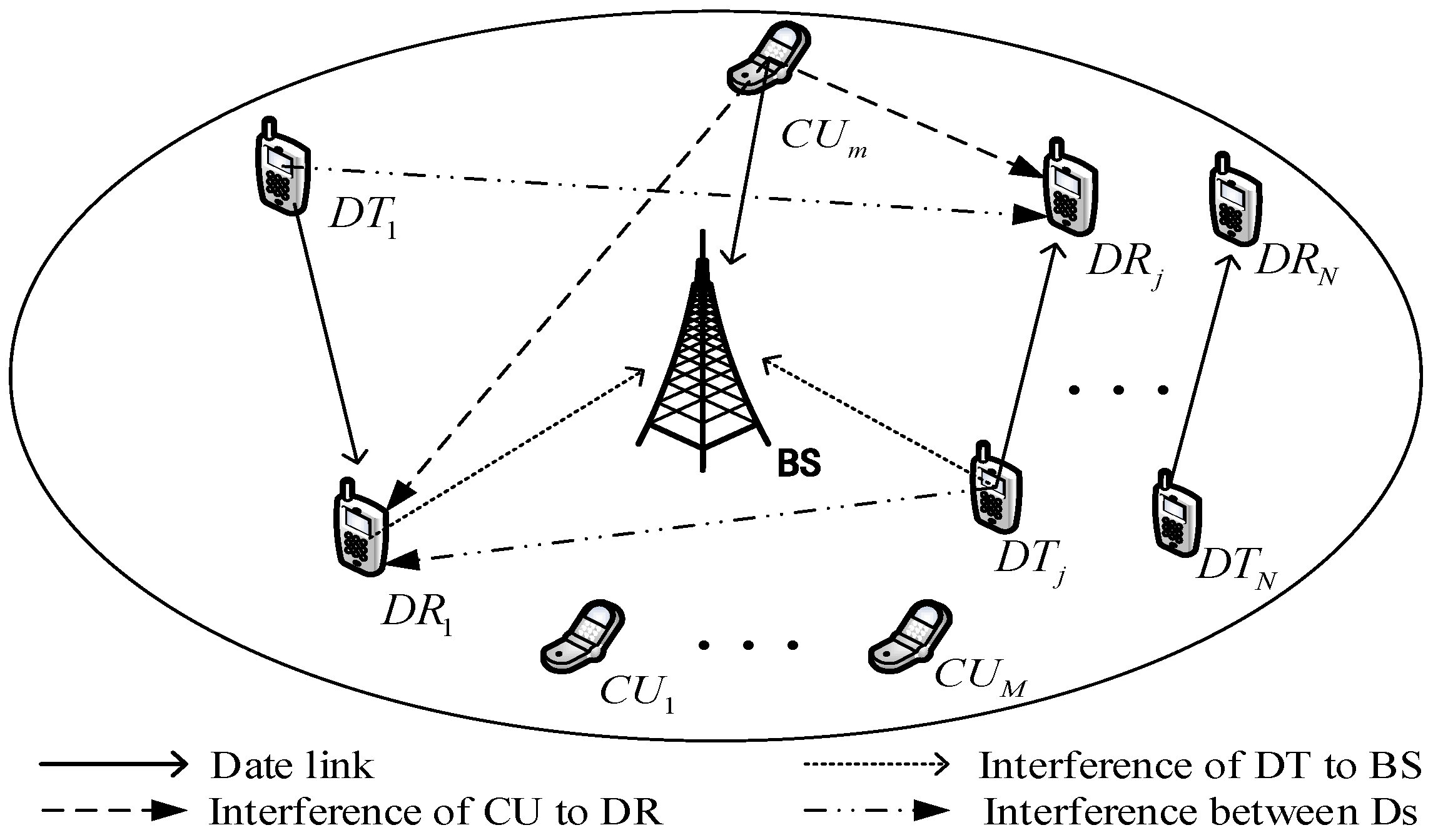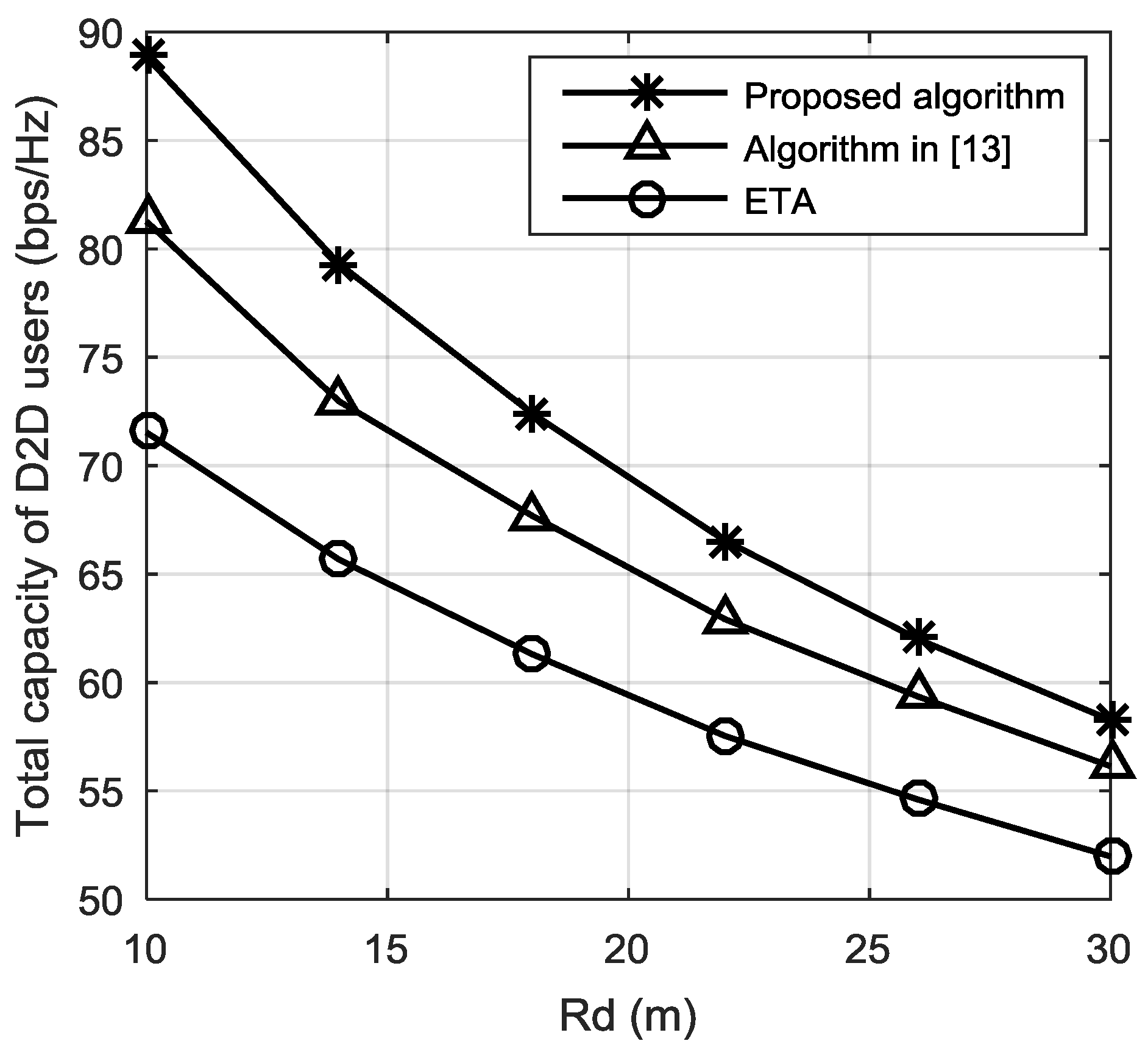Power Control and Channel Allocation Algorithm for Energy Harvesting D2D Communications
Abstract
:1. Introduction
- (1)
- The optimization problem of joint power control and channel allocation is constructed by considering the constraints of harvesting energy on transmission power, QoS (Quality of Service) of cellular users and channel multiplexing, so as to maximize the total capacity of D2D users. The original mixed integer nonlinear problem is transformed into a convex optimization problem by variable substitution and fractional programming.
- (2)
- The optimal joint power control and channel allocation algorithm is proposed. The optimal transmission power and energy harvesting time of D2D users are determined by the joint iterative method. The KM algorithm is used to complete the optimal matching between D2D users and cellular users’ channel.
- (3)
- The simulation results of the proposed algorithm are provided to verify the effectiveness of the proposed resource allocation algorithm. The system performance of the proposed algorithm in terms of D2D users’ total capacity is compared with the algorithm in [13] and equal time allocation (ETA) methods. The simulation results show that the proposed algorithm can effectively improve the system performance.
2. System Model
3. Optimal Joint Power Control and Channel Allocation Algorithm
3.1. Optimization Formulation
3.2. Optimal Joint Power Control and Channel Allocation Algorithm
| Algorithm 1. Optimal joint power control and channel allocation algorithm |
| Input: the set of cellular users , the set of D2D users , the tolerance . Output: the optimal transmission power of cellular user and D2D user and , the optimal energy harvesting time , the channel reuse indicator of D2D user . 1) Initialization: , , . 2) Divide D2D users into M clusters according to interference weight graph [16]. 3) For 4) For 5) While do 6) For 7) Calculate and with Equations (29) and (30); 8) End for 9) Calculate with Equation (15); 10) End while 11) Calculate , and with Equations (12)–(14); 12) End for 13) End for 14) Use the KM algorithm to achieve the optimal matching between D2D clusters and cellular users’ channels. |
4. Simulation Results and Discussion
5. Conclusions
6. Patents
Author Contributions
Funding
Conflicts of Interest
References
- Ahmed, M.; Li, Y.; Waqas, M.; Sheraz, M.; Jin, D.; Han, Z. A survey on socially aware device-to-device communications. IEEE Commun. Surv. Tutor. 2018, 20, 2169–2197. [Google Scholar] [CrossRef]
- Jameel, F.; Hamid, Z.; Jabeen, F.; Zeadally, S.; Javed, M.A. A survey of device-to-device communications: Research issues and challenges. IEEE Commun. Surv. Tutor. 2018, 20, 2133–2168. [Google Scholar] [CrossRef]
- Baniasadi, M.; Maham, B.; Kebriaei, H. Power control for D2D underlay cellular communication: Game theory approach. In Proceedings of the 2016 8th International Symposium on Telecommunications, Tehran, Iran, 27–28 September 2016; pp. 314–319. [Google Scholar]
- Jiang, Y.X.; Liu, Q.; Zheng, F.C.; Gao, X.; You, X. Energy-efficient joint resource allocation and power control for D2D communications. IEEE Trans. Veh. Technol. 2016, 65, 6119–6127. [Google Scholar] [CrossRef]
- Zhang, G.D.; Hu, J.M.; Heng, W.; Li, X.; Wang, G. Distributed power control for D2D communications underlaying cellular network using Stackelberg Game. In Proceedings of the 2017 IEEE Wireless Communications and Networking Conference, San Francisco, CA, USA, 19–22 March 2017; pp. 1–6. [Google Scholar]
- Ferdouse, L.; Ejaz, W.; Raahemifar, K.; Anpalagan, A.; Markandaier, M. Interference and throughput aware resource allocation for multi-class D2D in 5G networks. IET Commun. 2017, 11, 1241–1250. [Google Scholar] [CrossRef]
- Saleem, U.; Jangsher, S.; Qureshi, H.K.; Hassan, S.A. Joint subcarrier and power allocation in the energy-harvesting-aided D2D communication. IEEE Trans. Ind. Inf. 2018, 14, 2608–2617. [Google Scholar] [CrossRef]
- Gupta, S.; Zhang, R.; Hanzo, L. Energy harvesting aided device-to-device communication underlaying the cellular downlink. IEEE Access 2017, 5, 7405–7413. [Google Scholar] [CrossRef]
- Kuang, Z.F.; Liu, G.; Li, G.Q.; Deng, X.H. Energy efficient resource allocation algorithm in energy harvesting-based D2D heterogeneous networks. IEEE Internet Things J. 2018, 6, 557–567. [Google Scholar] [CrossRef]
- Yu, S.; Ejaz, W.; Guan, L.; Anpalagan, A. Resource allocation for energy harvesting assisted D2D communications underlaying OFDMA cellular networks. In Proceedings of the 2017 IEEE 86th Vehicular Technology Conference, Toronto, ON, Canada, 24–27 September 2017; pp. 1–7. [Google Scholar]
- Wang, L.Y.; Liao, X.W.; Li, Y. Transmission strategy for D2D terminal with ambient RF energy harvesting. In Proceedings of the 2017 IEEE 86th Vehicular Technology Conference, Toronto, ON, Canada, 24–27 September 2017; pp. 1–5. [Google Scholar]
- Gong, S.M.; Shen, Y.Y.; Huang, X.X.; Wu, X.X.S.; So, A.M.C. Robust relay beamforming in device-to-device networks with energy harvesting constraints. In Proceedings of the 2016 IEEE Global Communications Conference, Washington, DC, USA, 4–8 December 2016; pp. 1–6. [Google Scholar]
- Wang, H.C.; Wang, J.L.; Ding, G.R.; Han, Z. D2D communications underlaying wireless powered communication networks. IEEE Trans. Veh. Technol. 2018, 67, 7872–7876. [Google Scholar] [CrossRef]
- Hemour, S.; Zhao, Y.P.; Lorenz, C.H.P.; Dimitri, H.; Gui, Y.S.; Hu, C.M.; Wu, K. Towards low-power high-efficiency RF and microwave energy harvesting. IEEE Trans. Microw. Theory. Technol. 2014, 62, 965–976. [Google Scholar] [CrossRef]
- Yu, B.Z.; Zhu, Q. A QoS-based channel allocation and power control algorithm for device-to-device communication underlaying cellular networks. J. Commun. 2016, 11, 624–631. [Google Scholar]
- Wei, L.; Wei, Z.; Wen, X.; Tao, S. Dynamic clustering based sub-band allocation in dense femtocell environments. In Proceedings of the 2012 IEEE 75th Vehicular Technology Conference, Yokohama, Japan, 6–9 May 2012; pp. 1–5. [Google Scholar]
- Dinkelbach, W. On nonlinear fractional programming. Manag. Sci. 1967, 13, 492–498. [Google Scholar] [CrossRef]
- Feng, D.Q.; Lu, L.; Yi, Y.W.; Li, G.Y.; Feng, G.; Li, S.Q. Device-to-device communications underlaying cellular networks. IEEE Trans. Commun. 2013, 61, 3541–3551. [Google Scholar] [CrossRef]
- Zoya, P.; Erez, A.F.; Daniel, C.; Regan, Z. Low-power far-field wireless powering for wireless senors. In Proceedings of the 2013 IEEE Radio and Wireless Symposium, Austin, TX, USA, 20–23 January 2013; pp. 31–33. [Google Scholar]
- Zheng, C.; Huan, X.N.; Tuan, A.L.; Karamanoglu, M.; Ever, E.; Yazici, A. Secure wireless powered and cooperative jamming D2D communications. IEEE Trans. Green Commun. Netw. 2018, 2, 1–13. [Google Scholar]





| Parameters | Value |
|---|---|
| Cell radius R/m | 500 |
| Maximum transmission power of cellular user /dBm | 24 |
| Maximum transmission power of D2D user /dBm | 24 |
| Transmission power of BS /dBm | 46 |
| Noise power /dBm | −174 |
| Number of cellular users | 5 |
| Path-loss constant | 0.01 |
| Path-loss exponent | 3.5 |
© 2019 by the authors. Licensee MDPI, Basel, Switzerland. This article is an open access article distributed under the terms and conditions of the Creative Commons Attribution (CC BY) license (http://creativecommons.org/licenses/by/4.0/).
Share and Cite
Su, N.; Zhu, Q. Power Control and Channel Allocation Algorithm for Energy Harvesting D2D Communications. Algorithms 2019, 12, 93. https://doi.org/10.3390/a12050093
Su N, Zhu Q. Power Control and Channel Allocation Algorithm for Energy Harvesting D2D Communications. Algorithms. 2019; 12(5):93. https://doi.org/10.3390/a12050093
Chicago/Turabian StyleSu, Na, and Qi Zhu. 2019. "Power Control and Channel Allocation Algorithm for Energy Harvesting D2D Communications" Algorithms 12, no. 5: 93. https://doi.org/10.3390/a12050093
APA StyleSu, N., & Zhu, Q. (2019). Power Control and Channel Allocation Algorithm for Energy Harvesting D2D Communications. Algorithms, 12(5), 93. https://doi.org/10.3390/a12050093




